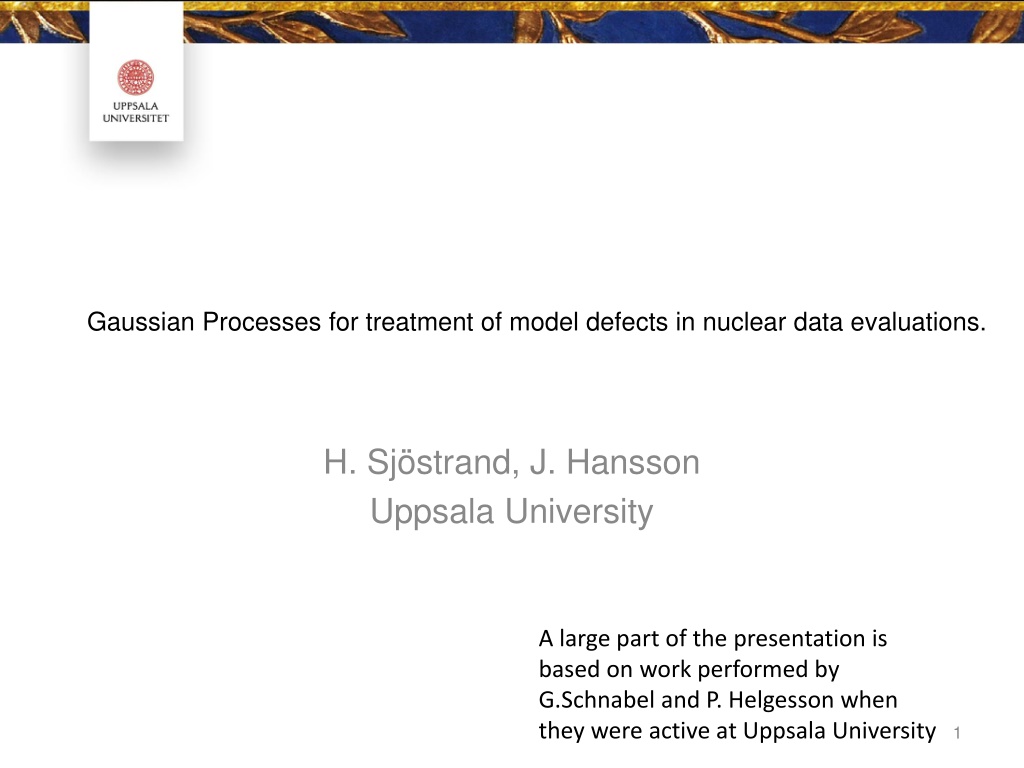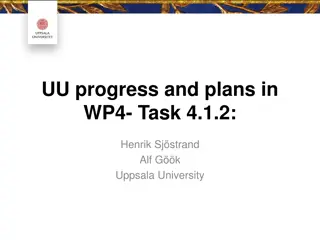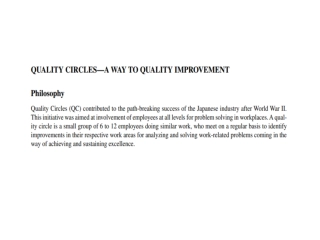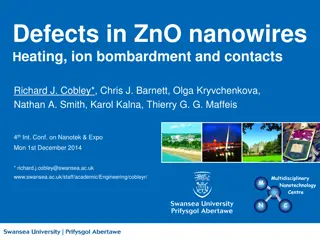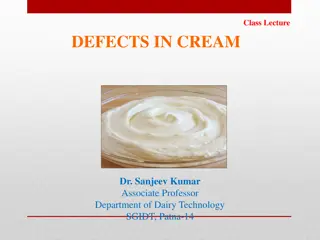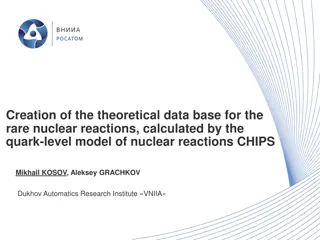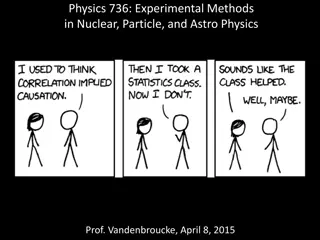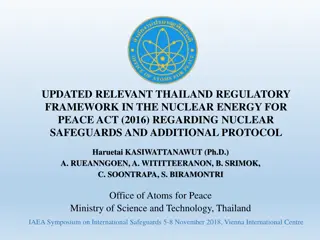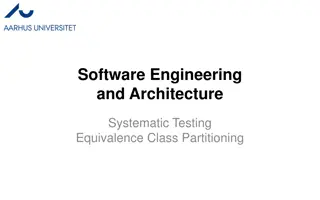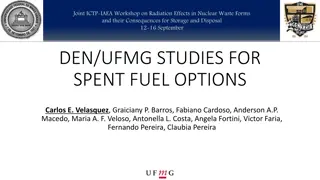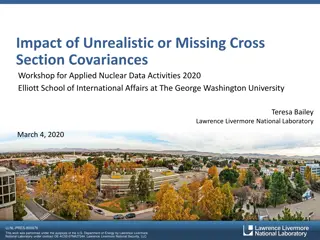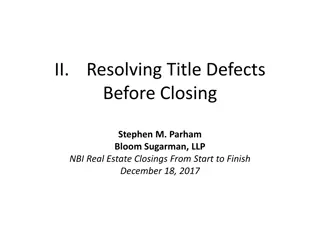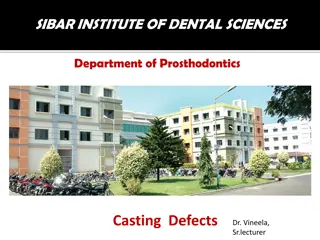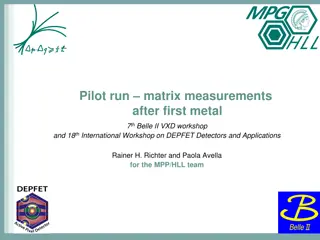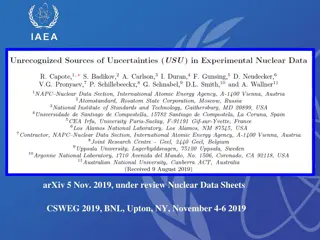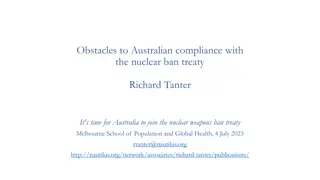Gaussian Processes for Treatment of Model Defects in Nuclear Data Evaluations
Gaussian Processes (GP) are explored for treating model defects in nuclear data evaluations. The presentation discusses the impact of model defects on evaluation results and proposes using GP to address these issues. The concept of GP and its application in treating model defects are detailed, highlighting the potential benefits in improving evaluation accuracy and accounting for data uncertainties.
Download Presentation

Please find below an Image/Link to download the presentation.
The content on the website is provided AS IS for your information and personal use only. It may not be sold, licensed, or shared on other websites without obtaining consent from the author. Download presentation by click this link. If you encounter any issues during the download, it is possible that the publisher has removed the file from their server.
E N D
Presentation Transcript
Gaussian Processes for treatment of model defects in nuclear data evaluations. H. Sj strand, J. Hansson Uppsala University A large part of the presentation is based on work performed by G.Schnabel and P. Helgesson when they were active at Uppsala University 1
Evaluation results sensitive to model defects Parameter domain (UMC - B) Observable domain (GLS) Error in evaluation P. Helgesson et al., Assessment of Novel Techniques for Nuclear Data Evaluation, Reactor Dosimetry: 16th International Symposium, Nov. 2018, doi: 10.1520/STP160820170087 Magnitude of model defect Plenty of evidence in literature that model defects deteriorate ND evaluations if not accounted for. 2
Can we treat model defects using Gaussian Processes? 3
Gaussian Processes A ( ) ( ) m prior 0; , '; , GP E E A , mean function Cov(x,x ; A, ) C. E. Rasmussen and C. K. I. Williams, Gaussian processes for machine learning. Cambridge, Mass: MIT Press, 2006. 4
Treating model defects with GP ( ) = E + + ; ; y f G P Standard treatment of model defect: j j m m ( ) ( ) m m prior 0; , '; , GP Prior E E A , http://www.it.uu.se/edu/course/homepage/apml/GP/ 5
Treating model defects with GP ( ) = E + + ; ; y f G P Standard treatment of model defect: j j m m ( ) ( ) m m prior 0; , '; , GP Prior E E A , A ( ) ( ) m prior 0; , '; , GP E E A , 2 ' E E = 2 A e 6
Hyper parameters ( ) m ( ) m prior 0; , '; , GP E E A , A ( ) Hyper parameters (A, ) determined by Marginal Likelihood Optimization Cross validation ( ) m prior 0; , '; , A GP E E , 2 ' E E = 2 A e 7
Solution 1: Treating model defects adding GP on the observable ) , m posterior f E + New model: ( ; j m Posterior None parametric Closed form solution Flexibility in choice of covariance. Account for data uncertainties 8
Results from PFNS synthetic data study P. Helgesson et al., Assessment of Novel Techniques for Nuclear Data Evaluation, Reactor Dosimetry: 16th International Symposium, Nov. 2018, doi: 10.1520/STP160820170087. (GP wok done by M. Grosskopf) 9
TALYS on (26FE56(N,P)25MN56 Residuals / m The model describes the data well ( ; j f E + ) m 10
TALYS on (26FE56(N,P)25MN56 Residuals / m Hard to integrate in a full evaluation (sum rules) Difficulties with constant hyperparameters (resonances) G. Schnabel and H. Sj strand, A first sketch: Construction of model defect priors inspired by dynamic time warping, EPJ Web Conf., vol. 211, p. 07005, 2019, doi: 10.1051/epjconf/201921107005. 11
Solution 2: GP in the parameter domain Energy-dependent parameters1,2around global parameters The energy dependence modeled with GP ??= ? ??;? + ?(??) + ? ; ??(?) ?? At each E: Consistent physics Meaningful parameters Extrapolation to other isotopes? [1] P. Helgesson and H. Sj strand, Treating model defects by fitting smoothly varying model parameters: Energy dependence in nuclear data evaluation, Annals of Nuclear Energy, vol. 120, pp. 35 47, Oct. 2018, doi: 10.1016/j.anucene.2018.05.026. [2]G. Schnabel,et al., Conception and software implementation of a nuclear data evaluation pipeline, arXiv:2009.00521 [nucl-ex, physics:nucl-th, physics:physics], Sep. 2020, http://arxiv.org/abs/2009.00521. 13
Observation Posterior The system gives flexibility to parameter best estimate parameter uncertainty Data at a certain energy will not constrain the model at all energies. 14
Reproduces data (26 FE 56(N,P)25 MN 56 but 15
Parameter variations Rapid variations in parameters Possibly to small uncertainties 16
Solution 3: Combining the methods prior m ( ) ( ) = f E + + + ; y E j j j m Note zero mean function 17
Observation 1 ( ) ( ) ( ) ( ) = f E + + = f E + + + ; y E ; y E j j j j j j m Adding also a GP on the observable side favors the prior Mostly small updates of the prior Smoother behavior 18
Observation 2 (26 FE 56(N,P)25 MN 56 Still reproduces data 19
Conclusions Model defects are a problem in nuclear data evaluation GP can be used to treat model defects 1. Adding GP on the observable 2. GP in parameter domain 3. GP parameter domain + GP prior on observable. Retains more of the model. Hypothesis: less sensitive to errors in exp. cov. Thank you for your attention ! 20
References P. Helgesson and H. Sj strand, Treating model defects by fitting smoothly varying model parameters: Energy dependence in nuclear data evaluation, Annals of Nuclear Energy, vol. 120, pp. 35 47, Oct. 2018, doi: 10.1016/j.anucene.2018.05.026. C. E. Rasmussen and C. K. I. Williams, Gaussian processes for machine learning. Cambridge, Mass: MIT Press, 2006. P. Helgesson et al., Assessment of Novel Techniques for Nuclear Data Evaluation, Reactor Dosimetry: 16th International Symposium, Nov. 2018, doi: 10.1520/STP160820170087. G. Schnabel, et al., Conception and software implementation of a nuclear data evaluation pipeline, arXiv:2009.00521 [nucl-ex, physics:nucl-th, physics:physics], Sep. 2020, http://arxiv.org/abs/2009.00521 G. Schnabel and H. Sj strand, A first sketch: Construction of model defect priors inspired by dynamic time warping, EPJ Web Conf., vol. 211, p. 07005, 2019, doi: 10.1051/epjconf/201921107005. G. Schnabel, Large Scale Bayesian Nuclear Data Evaluation with Consistent Model Defects, Ph.D, TUW, 2015. Supervisor .H.Leeb. 21
Extra 22
Model defects Model defects = the model cannot reproduce the reality The bias will supersede the estimated uncertainty Measurements Physical reality Linear model + uncertainties (95 %) The idea and part of the figure is adapted from Georg Schnabel, Large Scale Bayesian Nuclear Data Evaluation with Consistent Model Defects, Ph.D, TUW, 2015. Supervisor .H.Leeb. 23
Treatment: Uncertainty inflation The best estimated of the model is kept but the uncertainty is inflated. Inflated uncertainty 24
Treatment 2: Prediction / model correction The model defect is estimated and corrected for Model +model defect describe the the experimental observations. Model + model defect 25
On computational Vanilla gaussian processes scale poorly with data O(n^3) Solutions: Data reduction or approximate model Approximate model: - m pseudo inputs z - evaluate k(z,z') - linear interpolation to data points Integrates smoothly and takes full advantage of existing pipeline software Linear mapping matrices are sparse, ie. fast computations Care has to be taken to choose z such that features of the data are captured by the grid, ie. not too sparse 26
